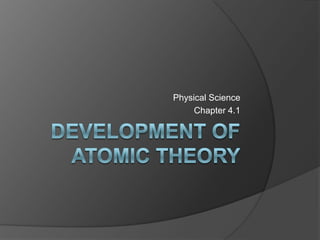Development of the Atomic Theory
•Als PPTX, PDF herunterladen•
7 gefällt mir•4,346 views
Melden
Teilen
Melden
Teilen

Empfohlen
Weitere ähnliche Inhalte
Was ist angesagt? (20)
DESCRIBE THE GENERAL TYPES OF INTERMOLECULAR FORCES

DESCRIBE THE GENERAL TYPES OF INTERMOLECULAR FORCES
Ähnlich wie Development of the Atomic Theory
Ähnlich wie Development of the Atomic Theory (20)
Mehr von Chris Foltz
Mehr von Chris Foltz (20)
Kürzlich hochgeladen
Mattingly "AI & Prompt Design: Structured Data, Assistants, & RAG"

Mattingly "AI & Prompt Design: Structured Data, Assistants, & RAG"National Information Standards Organization (NISO)
Organic Name Reactions for the students and aspirants of Chemistry12th.pptx

Organic Name Reactions for the students and aspirants of Chemistry12th.pptxVS Mahajan Coaching Centre
Kürzlich hochgeladen (20)
Interactive Powerpoint_How to Master effective communication

Interactive Powerpoint_How to Master effective communication
Call Girls in Dwarka Mor Delhi Contact Us 9654467111

Call Girls in Dwarka Mor Delhi Contact Us 9654467111
Z Score,T Score, Percential Rank and Box Plot Graph

Z Score,T Score, Percential Rank and Box Plot Graph
Measures of Central Tendency: Mean, Median and Mode

Measures of Central Tendency: Mean, Median and Mode
Mattingly "AI & Prompt Design: Structured Data, Assistants, & RAG"

Mattingly "AI & Prompt Design: Structured Data, Assistants, & RAG"
18-04-UA_REPORT_MEDIALITERAСY_INDEX-DM_23-1-final-eng.pdf

18-04-UA_REPORT_MEDIALITERAСY_INDEX-DM_23-1-final-eng.pdf
Organic Name Reactions for the students and aspirants of Chemistry12th.pptx

Organic Name Reactions for the students and aspirants of Chemistry12th.pptx
Hybridoma Technology ( Production , Purification , and Application ) 

Hybridoma Technology ( Production , Purification , and Application )
Development of the Atomic Theory
- 1. Development Of Atomic Theory Physical Science Chapter 4.1
- 2. Objectives Describesome of the experiments that led to the current atomic theory. Compare the different models of the atom. Explain how the atomic theory has changed as scientists have discovered new information about the atom. Bellringer The following is a quote by Democritus (c. 460–c. 370 bce). “Color exists by convention, sweet by convention, bitter by convention; in reality nothing exists but atoms and the void.” What do you know about Democritus? And why are his thoughts important?
- 3. The Beginning of the Atomic Theory 440 BCE, a Greek philosopher, Democritus thought that you would eventually end up with a particle that could not be cut. He called this particle an atom. Aristotle, another Greek philosopher, disagreed with Democritus He believed that you would never end up with a particle that could not be cut. atom smallest particle into which an element can be divided and still be the same substance.
- 4. Dalton’s Atomic Theory Published in1803. Stated that All substances are made of atoms. Atoms are small particles that cannot be created, divided, or destroyed. Atoms of the same element are exactly alike Atoms of different elements are different. Atoms join with other atoms to make new substances. Not Quite Correct The atomic theory was then changed to describe the atom more correctly.
- 5. Thomson’s Discovery of Electrons Negatively Charged Particles Used cathode-ray tube Discovered negatively charged particles electrons. Plum – Pudding model New model of the atom. Electrons were mixed throughout an atom, like plums in a pudding.
- 7. Rutherford’s Atomic “Shooting Gallery” Negatively Charged Particles 1909 Ernest Rutherford aimed a beam of small, positively charged particles at a thin sheet of gold foil. Surprising Results Expected the particles to pass right through the gold in a straight line. Surprise, some of the particles were deflected!!
- 8. Rutherford’s Model of atom
- 9. Where are the electrons? Far from the Nucleus Rutherford proposed that in the center of the atom is a tiny, positively charged part called the nucleus Nucleus is 100,000 times smaller than atom Bohr’s Electron Levels 1913 NielsBohr proposed that electrons move around the nucleus in certain paths, or energy levels
- 10. Size of the Nucleus
- 11. Modern Atomic Theory The Modern Atomic Theory Regions inside the atom where electrons are likely to found These regions are called electron clouds